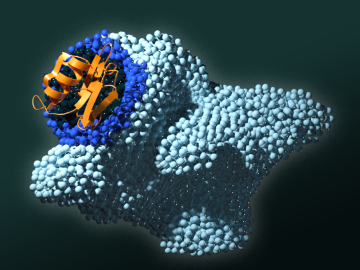
Filter News
Area of Research
- (-) Biology and Environment (52)
- (-) National Security (25)
- (-) Renewable Energy (1)
- Advanced Manufacturing (2)
- Biology and Soft Matter (1)
- Building Technologies (2)
- Clean Energy (49)
- Computational Biology (1)
- Computer Science (1)
- Electricity and Smart Grid (1)
- Functional Materials for Energy (2)
- Fusion and Fission (15)
- Isotopes (3)
- Materials (43)
- Materials for Computing (6)
- Neutron Science (14)
- Supercomputing (39)
News Topics
- 3-D Printing/Advanced Manufacturing (4)
- Advanced Reactors (1)
- Artificial Intelligence (6)
- Big Data (3)
- Bioenergy (15)
- Biology (26)
- Biomedical (3)
- Biotechnology (3)
- Buildings (2)
- Chemical Sciences (7)
- Clean Water (2)
- Climate Change (18)
- Composites (2)
- Computer Science (8)
- Coronavirus (3)
- Critical Materials (1)
- Cybersecurity (5)
- Decarbonization (8)
- Energy Storage (4)
- Environment (24)
- Exascale Computing (2)
- Frontier (2)
- Grid (5)
- High-Performance Computing (5)
- Hydropower (6)
- Machine Learning (6)
- Materials (4)
- Materials Science (2)
- Mercury (1)
- Microscopy (6)
- Nanotechnology (2)
- National Security (13)
- Net Zero (1)
- Neutron Science (2)
- Nuclear Energy (1)
- Partnerships (3)
- Physics (1)
- Polymers (1)
- Security (3)
- Simulation (1)
- Summit (3)
- Sustainable Energy (9)
- Transformational Challenge Reactor (1)
- Transportation (1)
Media Contacts

Scientists at ORNL have created a miniaturized environment to study the ecosystem around poplar tree roots for insights into plant health and soil carbon sequestration.

A team of scientists led by Oak Ridge National Laboratory developed a theory that thylakoids, membrane networks key to plant photosynthesis, also function as a defense mechanism to harsh growing conditions, which could aid the development of hardier plants.

Cameras see the world differently than humans. Resolution, equipment, lighting, distance and atmospheric conditions can impact how a person interprets objects on a photo.

When the COVID-19 pandemic stunned the world in 2020, researchers at ORNL wondered how they could extend their support and help

Chemical and environmental engineer Samarthya Bhagia is focused on achieving carbon neutrality and a circular economy by designing new plant-based materials for a range of applications from energy storage devices and sensors to environmentally friendly bioplastics.

Though Nell Barber wasn’t sure what her future held after graduating with a bachelor’s degree in psychology, she now uses her interest in human behavior to design systems that leverage machine learning algorithms to identify faces in a crowd.
Scientists at Oak Ridge National Laboratory are closer to unlocking the secrets to better soil carbon sequestration by studying the tiny, sand-like silicon deposits called phytoliths in plants.

Although more than 92,000 dams populate the country, the vast majority — about 89,000 — do not generate electricity through hydropower.

Science has taken Melanie Mayes from Tennessee to the tropics, studying some of the most important ecosystems in the world.

Researchers at ORNL have definitively linked the function of a specific domain of proteins important in plant-microbe biology to a cancer trigger in humans, knowledge that had eluded scientists for decades.


